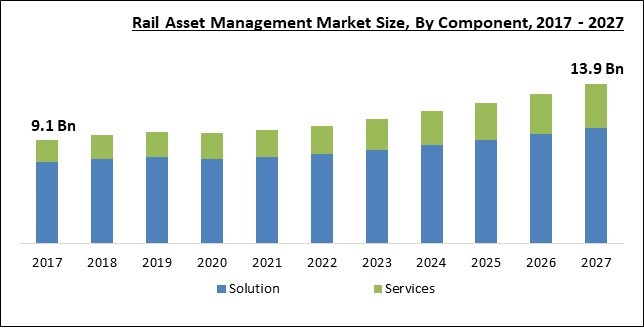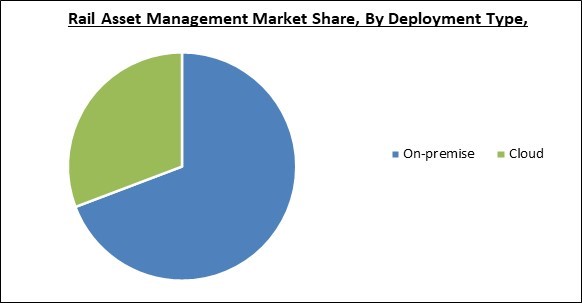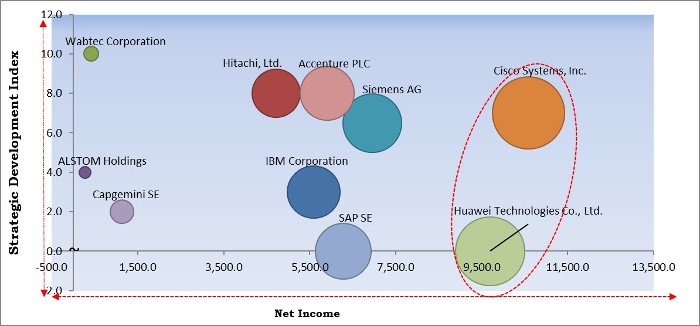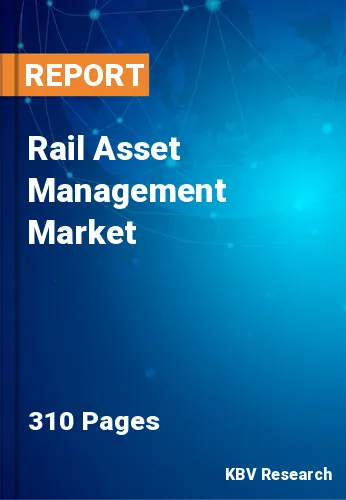The Global Rail Asset Management Market size is expected to reach $13.9 billion by 2027, rising at a market growth of 5.9% CAGR during the forecast period.
The term "asset management" has quickly gained traction in the rail sector. A combination of coordinated operations that optimize asset performance to assist an organization achieve its goals is the core defining principle of an often complicated system. It includes all systems, methods, and tools for maximizing asset availability at the lowest total cost and risk possible. This frequently entails the use of sophisticated software to collect and analyses usage data in order to perform predictive and preventative maintenance rather than reactive fixes.
The rail sector has a significant impact on a country's economic and financial situation. It transports billions of people and freights every day and creates enormous profits. The reliance on trains for both passengers and commodities is rapidly increasing owing to the ease and comfort of transportation. The majority of nations are spending considerably in rail infrastructure in order to give their citizens with a smooth rail experience.
Railways also assist governments in reducing the cost of passenger and freight transportation by providing a large carrying capacity in a single run. The increasing reliance on trains is putting further strain on the current rail system. Due to system wear and tear, breakdowns, damages, and repair demands, this results in a slew of unplanned and unplanned maintenance with both rolling stock and infrastructure.

Due to tight mobility limitations enforced by municipal and national governments, the spread of the virus has hindered the expansion of rail asset management solutions. However, many rail operators are seeing a surge in demand for novel rail asset management solutions that can successfully combine IoT, analytics, big data, security, cloud, and network connectivity. Regulatory authorities in various countries are primarily focused on providing faster medical care and emergency support services, so the adoption of IoT and cloud for emergency services and healthcare services is expected to increase the adoption of rail asset management solutions during the pandemic.
All kind of transport mediums were stopped in order to prevent a huge spike in COVID-19 cases, which has negatively impacted the growth of the railways sector as well as rail asset management market.
Rail assets must be properly scheduled, monitored, and maintained for an efficient rail operation. Due to downtime, maintenance plans diminish asset productivity. Because manual diagnostics have a low success rate, this downtime is extended even more. Rail authorities are working substantially on condition-based and predictive maintenance technologies to improve efficiency and reduce time consumption. These technologies aid in prompt asset monitoring and efficient asset scheduling, reducing downtime. The use of real-time analytics for condition-based and predictive maintenance reduces the need for manual diagnostics.
Because of their effective IT administration and secure security environment, demand for cloud-based services, internet technologies and analytics is growing. The big data cloud approach is, without a doubt, rail transportation's best opportunity to accommodate the changing structure of data and maximize its use. It has the potential to create a significant shift for all rail management organizations, enabling them to improve both rail infrastructure and operations. Because of the expanding data, evolving technologies and the growing need to improve cost-efficiency, the degree of difficulty in big data applications is likely to rise. These considerations are likely to have an impact on the implementation of innovative analytics platforms and data storage.
Project funding for large initial capital expenditure is one of the primary barriers for the rail asset management market's growth. The national/local governments have taken on the primary task of extensively investing in the rail infrastructure modernization process. It's simple to see how, even if governments have the need, vision, and clarity for these kind of reforms, a lack of budgetary allocations for large-scale deployments slows the transformation process down, either directly or indirectly. Such large investments may increase the economic strain on debt-ridden states or local governments, putting future general budgets at risk.

Based on Component, the market is segmented into Solution and Services. Further, the solution segment is bifurcated into Asset Performance Management (APM), Asset Planning & Scheduling, Workforce Management, Security, Analytics, Network Management, Incident Management, and Others. Based on Services, the market is segmented into Professional Services and Managed Services. The services segment registered a substantial revenue share in rail asset management market in 2020. Service segment is further divided into managed services and professional services. The growth of the segment is attributed to the fact that many companies are investing a huge amount in hiring dedicated or professional workforce. In addition, several companies would outsource rail asset management services and hence, contributing the growth of the segment.
Based on Deployment Type, the market is segmented into On-premise and Cloud. The on-premise segment garnered the largest revenue share in the rail asset management market in 2020. The on-premises deployment is method in which software and solutions are installed on the company's premises. The organization is responsible for sustaining the solution and all related processes under this deployment option.
Such solutions come with a one-time license price and an annual service agreement that covers free modifications, upgrades, and installation of new features. Rail asset management solutions that are deployed on-premises require dedicated equipment and servers. It also necessitates the hiring of dedicated IT personnel to maintain and support the high-end IT infrastructure. On-premises solutions are typically used by companies who can afford to manage dedicated servers. Offline data analytics and setup are also available in the on-premises deployment mode, which gives users more control over their systems and data.
Based on Application, the market is segmented into Rolling Stock and Infrastructure. The rolling stock segment dominated the rail asset management market with the maximum revenue share in 2020. The railway industry is an asset-intensive industry, with rolling stock being one of the most important asset types. The rail operator can save a large amount of money by efficiently managing rolling stock. Rolling stocks typically have a lengthy service life, therefore keeping one in service for that long might present a number of servicing issues, like securing parts, unexpected repair, and so on. Asset management solutions for rolling stocks could help you get a better handle on asset performance, make better use of resources, and manage risk more effectively. A large number of rail companies are spending in rolling stock.
| Report Attribute | Details |
|---|---|
| Market size value in 2020 | USD 9.6 Billion |
| Market size forecast in 2027 | USD 13.9 Billion |
| Base Year | 2020 |
| Historical Period | 2017 to 2019 |
| Forecast Period | 2021 to 2027 |
| Revenue Growth Rate | CAGR of 5.9% from 2021 to 2027 |
| Number of Pages | 310 |
| Number of Tables | 544 |
| Report coverage | Market Trends, Revenue Estimation and Forecast, Segmentation Analysis, Regional and Country Breakdown, Competitive Landscape, Companies Strategic Developments, Company Profiling |
| Segments covered | Component, Deployment Type, Application, Region |
| Country scope | US, Canada, Mexico, Germany, UK, France, Russia, Spain, Italy, China, Japan, India, South Korea, Singapore, Malaysia, Brazil, Argentina, UAE, Saudi Arabia, South Africa, Nigeria |
| Growth Drivers |
|
| Restraints |
|
Based on Regions, the market is segmented into North America, Europe, Asia Pacific, and Latin America, Middle East & Africa. Europe emerged as the leading region in the rail asset management market with the largest revenue share in 2020. Western European countries with well-established railway infrastructure, like France, the United Kingdom, and Germany, employ a variety of advanced rail asset management solutions. European countries have made significant investments in modernizing and upgrading their rail systems. Large-scale, cross-border trade and passenger traffic have increased in Europe as a result of EU social and trade accords. The region is expected to witness rapid adoption of rail asset management solutions, particularly in communication technology, thanks to the formation of a separate committee by the European Telecommunications Standards Institute (ETSI) to focus on Machine-to-Machine (M2M) communication privacy standardization and high trading standards.
Free Valuable Insights: Global Rail Asset Management Market size to reach USD 13.9 Billion by 2027

The major strategies followed by the market participants are Acquisitions. Based on the Analysis presented in the Cardinal matrix; Cisco Systems, Inc. and Huawei Technologies Co., Ltd. are the forerunners in the Rail Asset Management Market. Companies such as Siemens AG, IBM Corporation, and Hitachi, Ltd. are some of the key innovators the Market.
The market research report covers the analysis of key stake holders of the market. Key companies profiled in the report include ALSTOM Holdings, Siemens AG, IBM Corporation, Hitachi, Ltd. (Hitachi ID Systems, Inc.), SAP SE, Cisco Systems, Inc., Capgemini SE, Accenture PLC, Wabtec Corporation, and Huawei Technologies Co., Ltd. (Huawei Investment & Holding Co., Ltd.)
By Component
By Deployment Type
By Application
By Geography
The rail asset management market size is projected to reach USD 13.9 billion by 2027.
Increasing geriatric population are driving the market in coming years, however, an increasing number of drugs and therapies for enhanced sleep limited the growth of the market.
ALSTOM Holdings, Siemens AG, IBM Corporation, Hitachi, Ltd. (Hitachi ID Systems, Inc.), SAP SE, Cisco Systems, Inc., Capgemini SE, Accenture PLC, Wabtec Corporation, and Huawei Technologies Co., Ltd. (Huawei Investment & Holding Co., Ltd.)
The Cloud segment has high growth rate of 7.4% during (2021 - 2027).
The Europe is fastest growing region in the Global Rail Asset Management Market by Region 2020, and would continue to be a dominant market till 2027.
Our team of dedicated experts can provide you with attractive expansion opportunities for your business.

